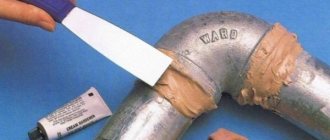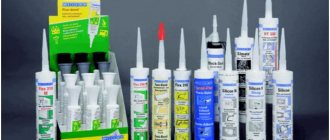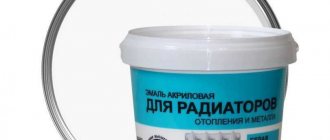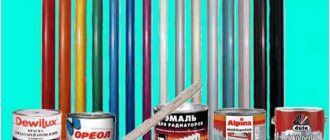Modifications of wall heaters for the bathroom
Today, a heated floor is often used to heat a bathroom. The solution is reasonable, but where to dry the robes and towels? Not on the floor. Heated towel rails and electric heaters will help solve the dilemma. The devices combine perfectly with a heated floor system - the towels dry quickly and your feet are always warm.
Water heated towel rails
This invention is not new. Every Soviet bathroom had a coil with paint peeling off from dampness. All sorts of small things like socks and handkerchiefs were dried on it. Today, the bent pipe has been replaced by an elegant chrome-plated device that performs the same functions. Such a device is powered from a hot water supply or heating system.
The coil must be made of stainless steel, because... a steel tube in a humid environment will quickly become unusable. A heated towel rail made of copper and brass can be connected to an autonomous heating system.
Electric heated towel rails
If the house does not have hot water supply and water heating, an electric heater is installed in the bathroom. It is connected to a 220 volt alternating current network and operates on the principle of an oil radiator. A coolant circulates through the tubes of the device, heated by the heating element. A standard electric battery for a bathroom is made in the form of a coil or ladder.
Electric heated towel rail in the form of a coil
Modern models consume no more energy than incandescent lamps. For convenience, the device is equipped with a timer and thermostat, with which you can set the operating schedule and temperature range.
Finally. When choosing a radiator for a bathroom, you don’t need to look at the design - the radiator can be covered with a decorative screen if necessary. Practicality, reliability, and heater power should come first. Savings are also inappropriate here. An expensive, high-quality device installed by a specialist will work for many years and will recoup its cost many times over.
Classification of heated towel rails
Dryers are divided into different groups according to type, size, installation method and material.
By type of coolant connection
The type of connection also determines three types of heated towel rails, and the type of connection plays one of the key roles when choosing a specific model.
- Water heated towel rail. Connects to the hot heating system. Heating occurs during the passage of a heated working environment. It is important to choose a model made of material that is resistant to aggressive water. During operation, there may be a risk of destruction of the structure of the internal walls, so the level of rigidity is an important factor when choosing . Made from stainless steel with a chrome finish , this is an excellent option that will last for many years.
- Electric heated towel rail. Does not depend on central heating . Requires an outlet at the installation site. Allows you to use yourself when necessary. There is a function for self-regulation of temperature data. Characterized by increased energy consumption.
- Combined heated towel rail. The most practical scheme for installation at home. You choose the connection type that is convenient for you. Alternating the heating method is optimal in different seasons of the year. So, you save money on utility bills. The cost of this modification is an order of magnitude more expensive than the above analogues.
Divided by size format
This variety is more of a design definition than an actual characteristic; it all depends, trivially, on the ratio of height and width.
- Horizontal heated towel rail. Combines the features of a dryer and radiator for heating. Installed as a window sill option. Will fit into any design. Does not take up a large area during installation.
- Vertical heated towel rail. It takes up an order of magnitude more space to be placed on the wall. Provides a large usable drying area. Available in exclusive shapes that will make your home decor stand out.
Type
There are 3 types:
- Mermen. Powered by hot water. The advantages include durability, strength, no additional maintenance costs, and low cost. There are no maintenance requirements; replacement is required primarily not due to breakdown, but for aesthetic reasons. The disadvantage is the dependence on hot water supply or heating (to which the dryer is connected). Some devices only work in winter, when the apartment is heated. Others become cold when there is no movement of hot water through the pipes.
- Electric ones are connected to the network for continuous operation. Their disadvantage is expensive maintenance. They are easier to install than water ones, because you don’t need to drill the walls, connect to the water supply, or use additional fittings.
- Combined ones combine the characteristics of both types. These heated towel rails are connected to both a hot water source and an electrical outlet. The ability to change modes allows you to always maintain a comfortable room temperature.
We recommend: Installing heated electric floors
By material
Dryers are made from different materials:
- Stainless steel will withstand high pressure. The walls of the pipe must be at least 3 mm thick.
- Steel is a cheap material. Dryers made from it are no longer sold, but most old houses have them installed.
- Copper is resistant to corrosion and conducts heat well. Such a product will not be heavy and looks good in appearance. Check that the pipe is galvanized on the inside for greater protection against water. The disadvantage of this option is the expensive price.
- Brass has the same “advantages” as copper. Products made from it are cheaper. The "disadvantage" is fragility. You should only buy dryers with chrome-plated inner walls.
Other non-ferrous metals and alloys (for example bronze) can also be used. Such products are rarely used due to their high cost.
Non-ferrous metals are often used to create designer dryers of non-standard shapes and colors.
Advantages of contacting the company Warmth and comfort
- Experience of specialists in the field of installing batteries in the bathroom. Our professionals are ready to perform installation in an apartment, country house, or other facility.
- Individual approach. When improving heating systems, specialists always take into account the wishes of the customer. Just let us know in advance which batteries you want to use and how to install them.
- Efficiency in solving problems. The installation of radiators will be completed as soon as possible. In the near future you will be able to start using your heating system with new high-quality batteries.
- Availability of professional equipment. We have everything necessary for installation work.
- Accurate execution of work. Installation of heating radiators is carried out not only quickly, but also very carefully. Certified welders and other qualified personnel comply with all established requirements.
- Consulting support. You can always ask our specialists any questions about batteries, pipes, fittings. Managers will tell you about all the main models and components.
Contact us! We will help make your bathroom warm, cozy and comfortable! With modern, stylish batteries it will look as attractive as possible.
The bathroom should be warm - this is an axiom
In this small but extremely important room for any family, children are bathed, washed, and clothes are washed and dried. To create a comfortable microclimate in the bathroom, you need a source of dry heat
A radiator in the bathroom will not only warm you up and help dry your laundry, but will also help prevent the appearance of mold and unpleasant odors. In this case, it is desirable that the functionality of the device be combined with its aesthetic appearance.
History of creation
In 1867, Georges Leclanche invented the first variation of a chemical current source. The first battery was very different in appearance compared to its modern counterpart.
However, the idea of storing electricity was first introduced in the development of A. Volta; most people, when asked who invented the battery, name him. Everedy was the first to produce autonomous power supplies for miners. Later, people who went on long voyages began to use the device.
A big step in the development of DC batteries was made by Duracell, which produced cheap and compact types of power supply. A graphite rod embedded in manganese oxide was placed in a zinc glass. Until the mid-20th century, this type and operating principle of the battery remained unchanged.
The discovery was the invention of lithium batteries. They accumulated more energy than their predecessors. Over time, the sources have undergone a huge number of changes. There are many options for how a battery is designed.
Universal insertion method
The coil operates on the principle of a gravity pump. If you insert it correctly, natural circulation and proper operation of the radiator are guaranteed. It is necessary to develop an installation diagram, strictly following the model instructions, and also taking into account the location of the riser in the bathroom.
For most models, the best option for tapping is to supply the coolant through the upper outlets (and the outlet is made from below). This is achieved using universal connections for the battery in the bathroom (photos of examples of work are in our article). This type of insert has a number of advantages:
- the direction and speed of water supply in the riser do not in any way affect the performance of the battery;
- there is no need to bleed air after circulation is turned off.
Another important advantage is the independence of the installation from the location of the riser.
Connection
Water heater
How to properly connect a water heated towel rail or radiator?
- A bypass is required before the dryer or radiator. It will ensure the passage of the riser or liner when the heater is turned off (for example, in the summer heat);
- To shut off the dryer, it is better to install ball valves rather than screw or plug valves. They do not require maintenance, always hold water tightly and have a huge resource;
- It is better to connect both the dryer and the radiator not with spurs, but with American ones. In this case, installing and dismantling the heated towel rail (for example, to lay tiles underneath) will take no more than a couple of minutes.
Electric heater
Heated towel rails, with their ridiculous power, can be connected to any outlet, regardless of grounding or wire size. But for full-fledged heaters, the instructions are somewhat more complicated:
- The outlet must be connected to ground and have appropriate terminals. The bathroom is a damp room, and a phase short circuit to the housing can lead to the most unpleasant consequences;
- The socket must have a cover that protects it from splashing water;
Wiring is calculated based on 1 mm2 copper wire cross-section for 8 amperes peak current. Let me remind you: current is equal to the result of dividing the power in watts by the supply voltage in volts. So, for a 2 kW device you need a copper wire of at least 2000/220/8 = 1.36 mm2.
Design
The most common among ceramic heaters are panel heaters. The case is metal with a polymer coating inside. For heating, heating elements, halogen, and carbon lamps are used. A heat-reflecting screen is installed between the rear wall of the housing and the heater. A ceramic plate is mounted on the front side.
When connected to the network, the heater heats up, heat is transferred to the ceramic surface, causing infrared radiation. Part of the thermal energy is dissipated in space by convection.
A ceramic stove works like a battery. It emits heat for 15-20 minutes after disconnecting the device from the network, heating the room.
Ceiling heater
What if you remove the radiator from the bathroom?
There is a category of citizens for whom not only the radiator in the bathroom, but even the heated towel rail is in the way and they decide to eliminate them. Immediately there is more space, neat and minimalistic, in a word – fashionable. But you can get the following results:
- temperature decrease below a comfortable level;
- increased humidity - as a result, the appearance of fungus;
- imbalance of the heating or hot water system.
This means that it is impossible to change the battery in the bathroom without employees of the service organization. They install the heat exchanger taking into account the design data of its hydraulic resistance. This is necessary for the system to be balanced. It is prohibited to even move the radiator to another place, much less completely dismantle it. We strongly do not recommend removing heating appliances from the bathroom.
How to hide a battery in the bathroom
How to make a radiator less noticeable? There are four ways to disguise radiators in the bathroom:
- Construction of a plasterboard box. To do this, you need to use moisture-resistant plasterboard sheets, because ordinary ones will not cope with extreme temperature conditions. The structure is constructed in the simplest way: a box is made from profiles, sheets cut to shape are placed on it. You need to make several holes in the top sheet so that warm air can escape into the room.
- Decor using tiles. This method is similar to the previous one, but differs in an increased level of energy consumption.
- Disguise behind plastic panels. This method is the simplest and relatively cheap. The low level of fire resistance is the main disadvantage of this method.
- Disguise with blinds. This method is suitable for those who value the usable space of the bathroom. Blinds allow you to have constant access to communications.
In addition to these four methods, there is also a radical one - installing the battery directly into the bathroom wall. However, due to the complexity and impossibility of servicing during an unusual situation, it is better not to tempt fate and not to commit rash acts.
Nowadays this is becoming less and less common, but some still have a cast-iron radiator in the bathroom, which was installed under the Soviets. It is clear that during repairs it is replaced with a heated towel rail, the thermal power of which is usually sufficient. In an apartment, the bathroom is small, but in cottages, for example, bathrooms are made large, so just a towel is not enough to heat it. You need to install an additional battery.
No. 10 Incorrect placement of the radiator
Equally important is the correct placement of the battery in relation to the wall. It is often placed under the windows, because it is through them that the greatest amount of heat escapes
They make mistakes when setting the depth of the device when it is either close to the wall or too far from it. The optimal distance is 2 cm.
You also need to pay attention to the height setting. If the radiator in the apartment is too close to the floor, this leads to poor heat transfer and air circulation.
You should retreat 6-10 cm from the floor. Excessively high placement of the device is also not allowed, especially with a window sill hanging over it. The consequences will be the same as with low placement. You need to leave at least 5-10 cm to the bottom line of the window sill.
The worst thing is to install heating devices inside niches and cover them with a decorative grille or screen. The air flow will decrease by 2-3 times, which will make the room noticeably colder. In order not to spoil the interior, it is better to resort to other methods of camouflage, for example, hanging curtains on the floor.
If you avoid the listed mistakes, the installation of a radiator in your apartment will go off without a hitch, and the result will delight the residents for many years.
Step-by-step installation of a battery in the bathroom
The first step is to prepare materials and tools. The tool is selected depending on the type of water supply pipes in the room. If installation is carried out through PP pipes, then it is necessary to ensure the availability of ball valves, mounting brackets, polypropylene pipes, a soldering iron and a knife for PP pipes.
The next step is dismantling the old equipment. Here you will need to do some preparatory work - if necessary, agree with the house management company on the possibility of disconnecting the riser from the water. Well, then - depending on the situation. If the coil is welded to the riser, you just need to cut it off with a grinder; if it is screwed on, unscrew it and dismantle it.
Step three. We install bypass and ball valves. Of course, the battery mount can be installed without a bypass, but following the recommendations of experts, it is better to install it. Ball valves must be installed at the ends of the dryer. This will allow you to shut off the water without turning off the riser.
The final step is installing the dryer coil. The process here is the same as with nailing a shelf to the wall. The only condition is to align the coil vertically and maintain the permissible distance from the wall.
Arguments and counter-arguments
Behind
- According to current SNiP, the temperature in the bathroom must be maintained at least +25C all year round. In the cold season, it is quite difficult to provide it without its own heat source in the room;
- In the limited space of a city apartment, the bathroom is often used for drying clothes. Where do you think it will dry faster - in a cold room or in a warm one?
The causes of fungus are cold and dampness.
Against
- In a cramped bathroom space, a radiator heated to 70 - 90 degrees often causes burns;
- In the summer heat, heating an already stuffy room becomes inappropriate.
Which battery to choose
When choosing a heating battery for a bathroom, you should take into account the fact that not every one of them can operate reliably and for a long time in conditions of high humidity.
To choose the right radiator, you need to take into account all the features of its operation.
Let's consider the main advantages of modern batteries.
Cast iron. Such products often look quite bulky, but are characterized by optimal heat dissipation and a long service life.
When choosing a battery, pay attention to the presence of a special protective coating (powder coating). Models with it are maximally resistant to corrosion and constant exposure not only to moisture, but also to steam, temperature changes, and aggressive detergents. Steel
Such products are not suitable for use in the bathroom. This is due to the fact that steel models rust quickly. The only exceptions are modern models made of steel with anti-corrosion coating. But often such radiators are quite expensive. Aluminum. Such models are compact and lightweight. They are ideal for bathrooms in private houses and cottages. Autonomous heating systems are not subject to hydraulic shocks. Thanks to this, you don’t have to worry about the battery simply breaking during one of them. Bimetallic. Such radiators in the bathroom can last up to 15-20 years. Bimetallic models cope excellently with all their functions. Original products also decorate the interior of the bathroom. They can be used as heated towel rails, robe hangers, mirror stands, etc.
| Description of service | Unit | Price |
| Manual arc welding of ferrous metals for | 1cm. seam | from 50 rub. |
| Pipe welding | 1 joint | from 200 rub. |
| Plumbing work | ||
| Replacing a heating radiator - batteries (2 pcs. or more) | 1 PC | 4000 rub. |
| Installation of a heated towel rail | 1 PC | from 1500 rub. |
| Insertion into the water supply/heating riser | PC. up to d50 | from 500 rub. |
| Installation of a jumper (bypass) for a heated towel rail | 1 PC | 6000 rub. |
| Filter and counter installation | PC. | 700 rub. |
| Replacing sewer pipes throughout the apartment | 1 point | from 500 rub. |
| Installation of supply pipes to the heated towel rail | 1 PC. | from 1500 rub. |
| Piping throughout the apartment is polypropylene | 1 PC. (hot water/hot water point) | from 2000 rub. |
| Replacing a hot/cold water riser with water access to an apartment (floor) | floor | 4500 rub. |
| Relocation of cold/hot water/heating riser (piece floor) | pcs. floor | 4000 rub. |
| Replacing the heating riser | floor | 3500 rub. |
| Replacing taps | PC | 500 rub. |
| Manufacturing of metal structures (cost of finished product) | ||
| Welded fencing (grids, gates) | p.m. | from 500 rub. |
| Fence (welded, chain-link mesh) | p.m. | from 1000 rub. |
| Trade and warehouse equipment (racks, shelving, furniture) | p.m. | from 1500 rub. |
| Metal structures and metal products according to customer drawings | ton | from 15,000 rub. |
| Piece products | negotiable | |
| Additional services | ||
| Painting work, surface priming | p.m. | from 50 rub. |
| Metal delivery in Moscow and the region | from 1500 rub. | |
| Cutting metal in one go | from 10 rub. | |
| Welding and installation work | negotiable |
Choosing a water heated towel rail
Choosing the right heated towel rail is a whole science, and especially a water one. The most important thing here is the shape, size and even the location of the bends, and there are also technical characteristics that also need to be taken into account.
Modern heated towel rail
Specifications
The operating pressure in the DHW system should be in the range from 0.3 atm to 6 atm. The pressure in the centralized heating system greatly depends on the area, but is rarely higher than 10–12 atm (in high-rise buildings). Select water dryers according to these parameters.
Before choosing a heated towel rail, pay attention to such an indicator as the maximum temperature. For hot water supply, this figure is rarely higher than 60 °C; for heating, few people give 80 °C. From this point of view, all stainless steel dryers are suitable, they have a maximum temperature of about 105–110 °C. Nevertheless, emergency situations occur when water is supplied heated to a hundred degrees or even higher, so this reserve will not hurt.
Deciding on the form
Water towel dryers come in different shapes. They can be divided into several groups:
- U or U shaped. The simplest in form and having the lowest cost. The disadvantages include their small “usable” area, as well as the not very large amount of heat that they can generate. You can't hang a lot of things on them. But such a towel dryer in the bathroom, with the correct size selection, can “stand” in the place of an old similar shape without modification.
- Snake, coil or M-shaped. A slightly more complex shape, more usable area and heat generated. They are also not very difficult to connect and have a low price. Snake dryer. Maybe not a masterpiece, but it lasts a long time
- Ladder. A heated towel rail consisting of a number of horizontal bars united at the edges by vertical collectors. The crossbars can be straight or in the form of a snake. Such a device usually has two connection methods - side and bottom. A more complex form requires a well-chosen scheme, otherwise it will not work. In addition, due to the high material consumption, the cost of such dryers is several times higher than coils.
- Non-standard complex shapes. There are unusual towel rails that look more like designer decorations than plumbing fixtures. Their prices are not low, and most of them are delivered “to order”. Problems often arise with their connection, so you need to choose the right circuit and consult a specialist.
Choosing a bathroom dryer according to its shape is both simple and difficult. You need to consider how and where you can install the design you like. At the same time, do not forget that you will have to connect it to a riser, which means pulling pipes along the walls to it. Moreover, most likely, the gasket will be hidden, that is, it will be hidden in the wall, which means that it will be necessary to ditch them or install a false wall.
Connection and installation features
An electric heated towel rail is connected to a regular socket, but since the installation location is a bathroom with high humidity, the voltage must be supplied through an RCD that breaks phase and zero; an automatic circuit breaker is also needed, perhaps one contact. The choice of their electrical parameters depends on what other devices will be connected to this line. It is not worth running a separate line to the heater due to its low power.
Thermostats have different shapes, but the functionality is usually the same
The heated towel rail can be installed anywhere. Usually the protection class allows it to be installed even above a bathtub (II), but this is hardly worth doing. It’s inconvenient, and things will get wet. It is usually best to install an electric dryer on any free wall. Often so that you can reach from the bathtub or shower stall. If the bathroom is combined, you will have to choose. You can also place it not far from the bidet or toilet with a hygienic shower. By the way, mounting brackets are usually included in the kit, so you don’t have to invent anything.
How to choose a battery for the bathroom
It is extremely difficult to remove the fungus.
There is no dispute about tastes, so everyone chooses the design of a heated towel rail or radiator for the bathroom for themselves
The first important decision is what the heat output of the heating device should be. If according to the rules, then you need to calculate heat loss
You need to be able to do this, as there are a lot of nuances. It is unlikely that you will be able to make a competent calculation at a glance. To get an accurate value, you need to contact professionals.
The popular method is to select a battery for the bathroom according to the area of the room. Yes, the resulting value will be approximate, but the calculation is not complicated, and most importantly, it works. For every meter you need 100 W of thermal energy (ceilings 2.5 m).
Having found out the required power, decide on the type of heating device:
Naturally, water heating registers include heating registers (battery and water towel). Their advantage is that there are no operating costs. The same cannot be said about electric heated towel rails, but they also have their strengths. This is work all year round without interruptions, a varied design, the ability to control the device remotely via smart sockets
Pay attention to the connections for connecting water towels to the circuit. They can be located on the side or bottom
The distance between them must coincide with the pipes on the risers.
How to adapt a fireplace for heating a dacha is written here.
Heating appliances in the bathroom
The heated towel rail performs the function of heating the bathroom.
There is no doubt that a battery is needed in the bathroom, but why is it there? We are talking about an ordinary radiator that is in every room. In the bathroom, the heated towel rail is mainly used as a heating device. This is, in fact, a water heating register, whose main function is heating. This means that he is also a kind of battery.
The bathroom is small, so a towel is usually enough. In large bathrooms, the power of a heated towel rail will not be enough; in this case, it is necessary to install a battery in the bathroom. Suitable for this:
The latter are the most practical and reliable. But it also happens that you inherited a cast-iron radiator in the bathroom along with the apartment. Previously, they weren’t particularly worried about making it beautiful. The main thing is quality and durability, so we installed ordinary cast iron radiators in three sections in the bathroom. Usually they are replaced with either a water heated towel rail or a combined unit (battery + heated towel rail). Here you need to look at the heat loss of the room.
Read more about the heating device in the country in this article.
Varieties
Thus, the rating includes Russian and European manufacturers using three construction materials:
- carbon steel;
- stainless steel;
- technical brass.
Corrosion-resistant alloy steel AISI 304 (domestic analogue 08Х18Н10) has cryogenic and heat-resistant properties and unlimited weldability. This allows you to reduce the weight of a heated towel rail of any configuration through the use of a thin-walled pipe.
Carbon steel is the most budget option, allowing you to reduce production costs. In this case, the wall thickness increases.
The last type of material is brass, which is practically not subject to corrosion. However, only well-known manufacturers with the highest level of technical equipment of their enterprises work with it.
When choosing the shape of a heating device, the following nuances must be taken into account:
- U-shaped models will heat poorly, there is not enough space on them for the bath accessories of a large family, but they can be mounted even under the sink in a small Khrushchev-era bathroom;
- M-shaped radiators are usually used when replacing old, worn-out heated towel rails, when you do not want to change the connection diameter and center-to-center distance;
- ladders come in different configurations and sizes, which allows them to be used as an independent design element in the interior;
- Large-sized partition PSs are ideal for a private house with large rooms.
In addition, ladders can have a narrow center-to-center dimension and can rotate the crossbars 180° in the vertical plane. Which allows, for example, to rotate them over the bathtub in those moments when no one is using it.
General installation requirements
Installation of a water-based battery is carried out in compliance with the basic requirements:
- The diameter of the dryer tubes should be equal to the diameter of the riser - no narrowing or expansion.
- It is necessary to install a jumper between the heated towel rail outlets.
- Shut-off valves must not be installed on the lintel. This also applies to the section of the pipeline up to the bypass.
- The dryer must be installed at a height of at least 120 centimeters from the floor.
- The distance between the wall and a heated towel rail with a tube diameter of up to 2.5 centimeters should be 3-4 centimeters. With a diameter of more than 2.5 - 6-7 centimeters.
Warranty, prices
Prices for radiators depend on their size and power, the material from which they are made, and the finish. A regular one costs from 4,900 rubles, an electric one - from 3,700 rubles.
You will pay about 3,300 rubles for a separate electric radiator. Warranties for electric dryers and heaters range from one to 2 years, although longer periods of up to 8 years are available.











